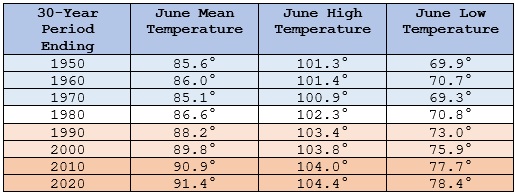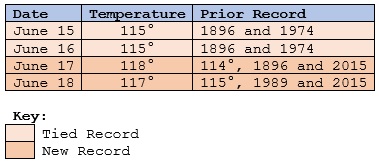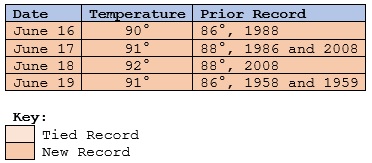The following was written yesterday by the brilliant Don Sutherland. He is well-known by readers of AmericanWx like @BHS1975, who read this same post. There’s no need for me to add anything else as Don explains it very well with amazingly detailed backing data and relevant sources:
————————
“Last year, Phoenix experienced a historically hot summer. Although the extreme heat held off through May this year, a severe heatwave developed toward mid-June.
The June 2021 heatwave was among Phoenix's and Tucson's most severe June heatwaves and their most severe heatwave this early in the season. This heatwave developed as an extreme upper air ridge evolved during an era of rising June temperatures and an ongoing drought. An extreme heat event commenced at Tucson on June 11 and it commenced at Phoenix on June 13.
Such events are likely to become even more frequent in the years ahead. Anthropogenic warming is creating a growing likelihood of long-duration extreme events through more frequent wave resonance events (Kornhuber et al., 2016 and Mann et al., 2017).
Already, the frequency and intensity of compound summertime hot extremes (events that combine daytime and nighttime heat where such temperatures are above their 90th percentile for their calendar) has been increasing especially in geographic locations that include the U.S. Southwest (Wang 2020). The increase in forcing associated with anthropogenic greenhouse gases is the dominant driver of this outcome (Wang 2020).
Table 1: Phoenix's High Temperatures during June 12-20, 2021

Table 2: Phoenix's Average June Temperatures (30-Year Moving Average)

Table 3: Phoenix's Record High Maximum Temperatures

Table 4: Phoenix's Record High Minimum Temperatures

A portion of this heatwave qualified as the 8th Extreme Heat Event (EHE) on record for June, as at least 3 days saw the maximum , temperature exceed the 97.5th percentile (Phoenix: 115° or above; Tucson: 110° or above), the high temperature average exceeded the 97.5th percentile (Phoenix: 115° or above; Tucson: 110° or above), and all high temperatures exceeded the 81st percentile (Phoenix: 110° or above; Tucson: 105° or above) in June-August high temperatures for the 1971-2000 base period (Clarke, et al.,2014). The extreme heat event began on June 11 in Tucson and June 12 at Phoenix.
Table 5: Phoenix's Extreme Heat Events in June (1896-2021)

Additional Records:
Earliest 116° or above high temperature: June 17, 2021 (old record: June 19, 2016 and 2017)
Earliest 4 consecutive 115° days: June 15-18, 2021 (old record: June 19-22, 1968)
Most consecutive 115° days: 6, June 15-20, 2021 (old record: 4, June 19-22, 1968; June 25-28, 1979; June 25-28, 1990; July 26-29, 1995; July 28-31, 2020; and, August 16-19, 2020)
Earliest 4-day average high temperature of 115° or above: June 14-17, 2021 (old record: June 18-21, 2017)
Earliest 5-day average high temperature of 115° or above: June 14-18, 2021 (old record: June 17-21, 2017)
Earliest 6-day average high temperature of 115° or above: June 13-18, 2021 (old record: June 18-23, 2017)
Earliest 7-day average high temperature of 115° or above: June 13-19, 2021 (old record: June 18-24, 2017)
Earliest 8-day average high temperature of 115° or above: June 13-20, 2021 (old record: June 18-25, 2017)
Earliest mean temperature of 100° or above: June 15, 2021 (old record: June 17, 2008)
Earliest 2-day average mean temperature of 100° or above: June 15-16, 2021 (old record: June 17-18, 2008 and 2015)
Earliest 3-day average mean temperature of 100° or above: June 14-16, 2021 (old record: June 17-19, 2015)
Earliest 4-day average mean temperature of 100° or above: June 14-17, 2021 (old record: June 18-21, 2017).”
————————
“Last year, Phoenix experienced a historically hot summer. Although the extreme heat held off through May this year, a severe heatwave developed toward mid-June.
The June 2021 heatwave was among Phoenix's and Tucson's most severe June heatwaves and their most severe heatwave this early in the season. This heatwave developed as an extreme upper air ridge evolved during an era of rising June temperatures and an ongoing drought. An extreme heat event commenced at Tucson on June 11 and it commenced at Phoenix on June 13.
Such events are likely to become even more frequent in the years ahead. Anthropogenic warming is creating a growing likelihood of long-duration extreme events through more frequent wave resonance events (Kornhuber et al., 2016 and Mann et al., 2017).
Already, the frequency and intensity of compound summertime hot extremes (events that combine daytime and nighttime heat where such temperatures are above their 90th percentile for their calendar) has been increasing especially in geographic locations that include the U.S. Southwest (Wang 2020). The increase in forcing associated with anthropogenic greenhouse gases is the dominant driver of this outcome (Wang 2020).
Table 1: Phoenix's High Temperatures during June 12-20, 2021

Table 2: Phoenix's Average June Temperatures (30-Year Moving Average)

Table 3: Phoenix's Record High Maximum Temperatures

Table 4: Phoenix's Record High Minimum Temperatures

A portion of this heatwave qualified as the 8th Extreme Heat Event (EHE) on record for June, as at least 3 days saw the maximum , temperature exceed the 97.5th percentile (Phoenix: 115° or above; Tucson: 110° or above), the high temperature average exceeded the 97.5th percentile (Phoenix: 115° or above; Tucson: 110° or above), and all high temperatures exceeded the 81st percentile (Phoenix: 110° or above; Tucson: 105° or above) in June-August high temperatures for the 1971-2000 base period (Clarke, et al.,2014). The extreme heat event began on June 11 in Tucson and June 12 at Phoenix.
Table 5: Phoenix's Extreme Heat Events in June (1896-2021)

Additional Records:
Earliest 116° or above high temperature: June 17, 2021 (old record: June 19, 2016 and 2017)
Earliest 4 consecutive 115° days: June 15-18, 2021 (old record: June 19-22, 1968)
Most consecutive 115° days: 6, June 15-20, 2021 (old record: 4, June 19-22, 1968; June 25-28, 1979; June 25-28, 1990; July 26-29, 1995; July 28-31, 2020; and, August 16-19, 2020)
Earliest 4-day average high temperature of 115° or above: June 14-17, 2021 (old record: June 18-21, 2017)
Earliest 5-day average high temperature of 115° or above: June 14-18, 2021 (old record: June 17-21, 2017)
Earliest 6-day average high temperature of 115° or above: June 13-18, 2021 (old record: June 18-23, 2017)
Earliest 7-day average high temperature of 115° or above: June 13-19, 2021 (old record: June 18-24, 2017)
Earliest 8-day average high temperature of 115° or above: June 13-20, 2021 (old record: June 18-25, 2017)
Earliest mean temperature of 100° or above: June 15, 2021 (old record: June 17, 2008)
Earliest 2-day average mean temperature of 100° or above: June 15-16, 2021 (old record: June 17-18, 2008 and 2015)
Earliest 3-day average mean temperature of 100° or above: June 14-16, 2021 (old record: June 17-19, 2015)
Earliest 4-day average mean temperature of 100° or above: June 14-17, 2021 (old record: June 18-21, 2017).”








